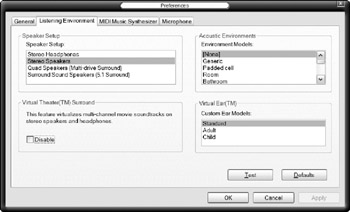Other Audio Control Utilities
Many audio device drivers also include their own control software that sometimes includes control settings that aren't available in the Windows Sounds and Audio Devices Properties dialog boxes. These programs often try to imitate the appearance of a stereo amplifier or some other piece of audio hardware. Some controls do exactly the same things as similar settings and options in the Sounds and Audio Devices Properties window, but others can change the character of the sound by altering equalization (relative level of high and low frequencies) and adding echo to the sound. For example, the SoundMax utility's main screen, shown in Figure 13.9, duplicates the controls in the Windows Volume Control window. However, the SoundMax Preferences window (see Figure 13.10) offers settings that can imitate many different acoustic environments and compensate for the different hearing ranges of adults and children.

Figure 13.9: The SoundMax control panel duplicates the Windows Volume Control.

Figure 13.10: SoundMax includes many settings and options that are not accessible from Windows.
In most cases, any configuration setting that changes the equalization or environment is more likely to degrade the sound rather than improve it. Go ahead and experiment with these options, but remember that the None options probably sound better than any other adjustment.
| CROSS-REF | See Chapter 42 for information about using your computer to play, record, and edit sound. |
EAN: 2147483647
Pages: 372